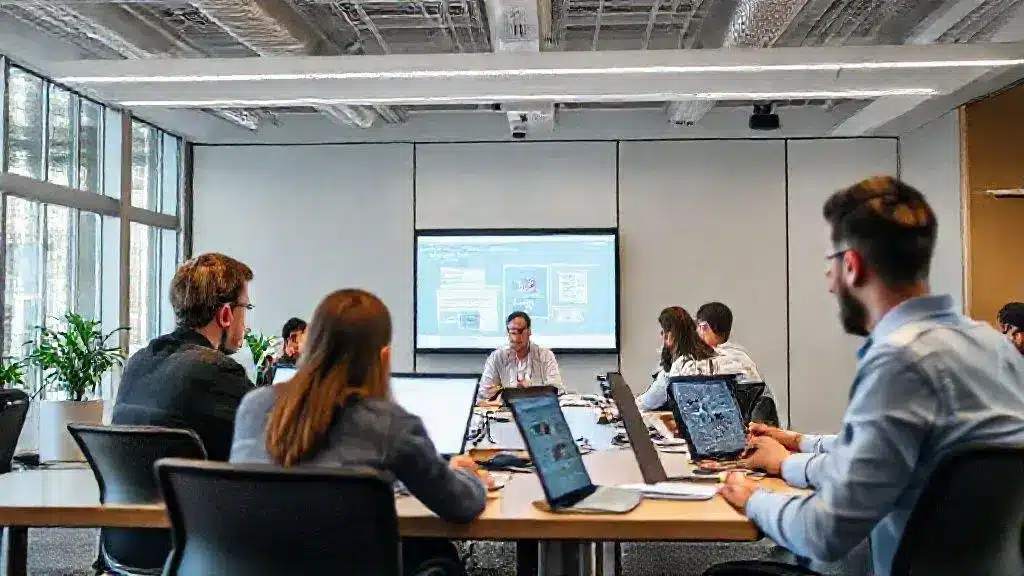First-generation EMBA enrollment spike: What it means for schools

The first-generation EMBA enrollment spike reflects a growing trend of diverse professionals seeking higher education, prompting business schools to adapt with flexible programs, enhanced support services, and industry partnerships to meet the evolving needs of students.
First-generation EMBA enrollment spike is changing the landscape of business education. Ever considered how this surge influences future leaders in our global economy? Let’s dive in!
Understanding the first-generation EMBA phenomenon
Understanding the first-generation EMBA phenomenon is crucial for grasping the evolving landscape of business education. This surge is characterized by an increase in students who are the first in their families to pursue an Executive MBA. Many individuals seek this degree for opportunities and skills that can elevate their careers.
Key Motivations for Pursuing an EMBA
There are various reasons driving this trend. For first-generation students, an EMBA often represents a path to breaking barriers and achieving career advancement. They see this degree as an investment in their future.
- Networking Opportunities: First-generation students benefit significantly from the connections made during their EMBA programs.
- Skill Development: Programs focus on practical skills that can be applied in real-world situations, enhancing professional competencies.
- Flexibility: Many EMBA programs cater to working professionals, allowing them to balance education with their careers.
Additionally, this phenomenon aligns with the growing recognition of diverse experiences in the business field. Employers are increasingly valuing the insights that diverse backgrounds bring.
The Impact on Business Schools
As business schools adapt to this change, they create more inclusive environments through tailored support services. These programs help first-generation students navigate the challenges that they might face. This trend is reshaping how institutions market their programs and develop their curricula.
In essence, understanding the first-generation EMBA phenomenon not only highlights the aspirations of these students but as well marks a significant shift in educational priorities. As more schools recognize this demographic, we expect to see continued innovations geared toward meeting their unique needs.
Key factors driving enrollment increases

Several key factors are contributing to the rising enrollment numbers in EMBA programs. These factors not only reflect the changing landscape of business education but also show what today’s professionals are seeking to advance their careers.
Investment in Education
Many individuals recognize an EMBA as a way to invest in their future. This degree often leads to better job prospects and higher salaries. For first-generation students, this investment is even more significant, as they aim to enhance their professional journey.
- Return on Investment: EMBA graduates frequently see a quick return on their educational investment through promotions and salary increases.
- Career Advancement: With an EMBA, graduates often qualify for leadership roles that were previously out of reach.
- Enhanced Skills: The curriculum is designed to provide practical skills applicable in today’s fast-paced business environment.
Another important factor influencing enrollment is the changing workplace dynamics. As companies evolve, there is a growing need for leaders who are not only knowledgeable but also adaptable to various challenges.
Accessibility and Flexibility
Many programs now offer flexible schedules, allowing students to balance their education with busy work lives. The rise of online learning has also made it easier for potential students to pursue an EMBA without relocating or sacrificing their current jobs.
The combination of these factors drives first-generation students to take the leap and enroll. The desire for advanced knowledge and the ability to network with peers are additional incentives.Enrollment spikes reflect a broader trend of professionals looking to enhance their resumes.
Implications for business schools and students
The increase in first-generation EMBA enrollments brings significant implications for both business schools and students. Understanding these implications can help institutions better serve their students while also enhancing educational outcomes.
Adapting Curriculum and Services
As more first-generation students enroll, schools are adapting their programs to meet diverse needs. This shift includes introducing tailored services that support students who might face unique challenges in their educational journey.
- Mentorship Programs: Establishing mentorship initiatives can connect first-generation students with alumni who have successfully navigated similar paths.
- Workshops on Soft Skills: These workshops help students strengthen vital skills such as negotiation and leadership, which are essential for their career growth.
- Financial Aid Resources: Increased financial aid options can support students who may face financial hurdles, making EMBA programs more accessible.
This growing demographic also influences how schools market their programs. They highlight inclusion and support to attract more first-generation students. Furthermore, fostering community within the student body is essential for creating a supportive environment.
Student Outcomes and Career Paths
The presence of more diverse voices in the classroom leads to enriched discussions and varied perspectives that benefit all students. This diversity encourages collaboration and innovation among peers. As a result, first-generation students often find themselves in leadership roles after graduation, paving paths for others.
This trend not only benefits the students themselves but also the organizations that employ them. Graduates with EMBA degrees are equipped with strategic insights and practical skills, allowing them to excel in their careers.
Future trends in executive education

The future of executive education is evolving rapidly, shaped by the increasing presence of first-generation EMBA students. Schools are adjusting their programs to keep up with trends that enhance learning experiences. These changes are paving the way for innovative educational formats and delivery methods.
Increase in Online Learning
Online learning has become more prevalent and accepted in executive education. Many programs are now offering fully online or hybrid options to provide greater flexibility for students. This shift allows busy professionals to balance their career while pursuing higher education.
- Accessibility: Online formats make education more accessible to individuals who may have previously found it challenging to attend in-person classes.
- Variety of Resources: Digital platforms offer a range of resources, including recorded lectures, discussion forums, and interactive modules.
- Global Reach: Students from diverse geographical locations can enroll, adding to the diverse perspectives in the classroom.
Additionally, as executive programs evolve, there is a significant focus on the incorporation of technology and data. Students are learning to harness big data to make informed business decisions.
Collaboration with Industry Leaders
Future executive education trends also include partnerships with industry experts. These collaborations can enhance curriculum relevance, ensuring that programs are aligned with current market demands.
Joint ventures between educational institutions and corporations provide students with practical experience. This hands-on approach is invaluable as it equips them with applicable skills right from the classroom to the workplace.
The landscape of executive education is set to grow increasingly dynamic, responding to the needs of a diverse and evolving student body. As institutions adapt, they create pathways for success that will shape the future leaders of various industries.
The rise of first-generation EMBA students is reshaping the landscape of executive education. Schools are adapting their programs to meet the needs of this diverse group, leading to innovative teaching methods and resources. As we anticipate future trends in this field, we can expect increased flexibility, collaboration with industry leaders, and a focus on practical skills. Ultimately, these changes will better prepare future students for success in their careers, creating a dynamic and inclusive educational experience.
FAQ – Frequently Asked Questions about First-Generation EMBA Enrollment
What factors have contributed to the increase in first-generation EMBA enrollments?
The rise is driven by greater accessibility, flexible learning options, and the need for diverse perspectives in the business world.
How do business schools support first-generation EMBA students?
Many schools offer tailored mentorship programs, financial aid resources, and workshops on essential skills to help these students succeed.
What role does technology play in executive education programs?
Technology enables online learning and the integration of data-focused courses, equipping students with practical skills for today’s job market.
How can partnerships with industry leaders benefit EMBA students?
Collaborations with industry experts provide students hands-on experience and relevant insights, enhancing the curriculum and real-world application.





